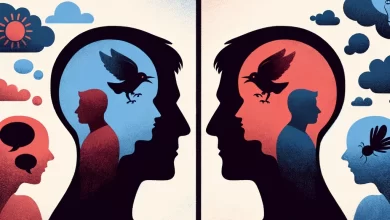Understanding Codependent Relationships Dynamics

Did you know that codependent relationships can occur in various dynamics, including romantic, family, or friendship scenarios?
Codependency, originally associated with addiction, is a broader pattern in which one person becomes overly reliant on another for support and validation. This unhealthy reliance often involves enabling the other person’s unhealthy behaviors.
In this article, we will explore the signs of codependency and the impact it has on individuals in relationships. We will also delve into the role of the enabler, the formation and origin of codependency, and provide insights on breaking free from codependent patterns through professional help and establishing healthier boundaries.
Key Takeaways:
- Codependent relationships can occur in various dynamics, including romantic, family, or friendship scenarios.
- Codependency involves one person becoming overly reliant on another for support and validation.
- It often manifests through enabling the unhealthy behaviors of the codependent individual.
- Signs of codependency include manipulative behavior, difficulty setting boundaries, justifying unreasonable actions, and seeking validation through others’ support.
- Professional help, such as therapy or addiction treatment, is often necessary to break codependent patterns and establish healthier boundaries.
Recognizing Signs of Codependency
Codependency is characterized by unhealthy attachment and codependent behavior in relationships. People who exhibit codependency often seek emotional validation and enable each other’s unhealthy behaviors, such as addiction or irresponsibility. Recognizing the signs of codependency is essential in understanding and addressing this pattern.
Signs of codependency include:
- Manipulative behaviors: Codependent individuals may manipulate others to meet their needs or control the relationship.
- Resistance to boundaries: Codependents have difficulty respecting and accepting boundaries set by others.
- Rationalizing unreasonable actions: They may justify their own or their partner’s unreasonable actions to maintain the relationship.
- Acting helpless to manipulate others: Codependents may act helpless to get others to do things for them or fulfill their emotional needs.
- Becoming disappointed or depressed when not rescued: They may become upset or depressed when they don’t receive the expected support or rescue from others.
- Using past events to justify current behaviors: Codependents rationalize their actions based on past traumas or experiences.
- Manipulating others for personal gain: They may manipulate others to serve their own interests or maintain control.
These signs indicate that codependency serves as a coping mechanism to avoid taking responsibility for one’s choices. Codependent individuals rely on others for their emotional well-being, rather than developing healthy coping skills and boundaries.
Recognizing these signs is an important first step towards breaking the cycle of codependency. Professional help, such as therapy and family intervention, is often necessary to address codependent behaviors and establish healthier dynamics.
“Recognizing the signs of codependency is crucial in understanding and addressing this unhealthy pattern. By acknowledging these signs, individuals can take the necessary steps to break free from codependent behaviors and cultivate healthier relationships.”
Codependent Behavior or Healthy Attachment?
It’s important to note that healthy attachment and codependent behavior are not the same. While healthy attachment involves emotional intimacy and reliance, codependency goes beyond healthy boundaries and becomes destructive. Codependency is characterized by an excessive need for validation and an inability to function independently.
Understanding the difference between codependent behavior and healthy attachment is crucial in recognizing and addressing codependency. Seek professional help to navigate these complexities and establish healthier relationship dynamics.
Understanding the Role of the Enabler
Codependent relationships involve both the codependent individual and the enabler. The enabler plays a crucial role in allowing and facilitating the codependent behaviors of the other person. They often have unmet emotional needs that are met through the codependent dynamics of the relationship. The enabler may have a desire to feel needed, fear abandonment, or find validation in rescuing others. They may also believe they deserve mistreatment or feel they won’t find another person who values them. Enablers struggle with setting boundaries, allowing the codependent person to continue their manipulative or abusive behaviors. Breaking codependent patterns often requires the enabler to change their enabling behaviors and establish healthier boundaries.
Validation from Codependency
Codependency provides a sense of validation and purpose for the enabler. By meeting the codependent person’s needs and putting their own desires aside, enablers believe they are fulfilling their role in the relationship. This validation helps them feel needed and rescues them from feelings of insignificance or abandonment. However, this validation is ultimately unhealthy and perpetuates the codependent dynamic. It is important for enablers to recognize that their self-worth should not depend on their ability to rescue or enable someone else’s unhealthy behaviors.
“Enablers struggle with setting boundaries, allowing the codependent person to continue their manipulative or abusive behaviors.”
The Struggle to Set Boundaries
Enablers often struggle with setting boundaries in codependent relationships. They may fear that establishing boundaries will lead to the codependent person’s rejection or abandonment. This fear can make it difficult for enablers to assert themselves and prioritize their own well-being. They may also believe that setting boundaries contradicts their role as a supportive and caring partner. However, setting and enforcing boundaries is essential for breaking the codependent patterns and promoting healthier relationship dynamics.
Breaking Codependent Patterns
To break codependent patterns, enablers need to take active steps towards change. This involves recognizing and challenging their enabling behaviors. Enablers must learn to prioritize their own needs and establish boundaries that protect their well-being. Seeking therapy or counseling can provide enablers with the guidance and support needed to break free from codependency. Through therapy, enablers can gain insight into their own motivations, develop healthier coping mechanisms, and learn effective boundary-setting strategies.
Establishing Healthier Boundaries
Establishing healthier boundaries is a crucial step in overcoming codependency. Enablers need to communicate their needs, wants, and limits clearly and consistently. This may involve saying “no” to enabling behaviors, asserting personal boundaries, and seeking support from friends, family, or professionals. By establishing and enforcing these boundaries, enablers can empower themselves, foster their own well-being, and contribute to the creation of healthier relationship dynamics.
| Signs of an Enabler in Codependent Relationships | Validation from Codependency | Struggle to Set Boundaries | Breaking Codependent Patterns | Establishing Healthier Boundaries |
|---|---|---|---|---|
| Enables codependent behaviors | Seeks validation and purpose in rescuing others | Fears rejection or abandonment | Takes active steps towards change | Communicates needs and limits effectively |
| Has unmet emotional needs | Feeling needed validates their self-worth | Believes setting boundaries contradicts their role | Seeks therapy or counseling for guidance | Enforces personal boundaries consistently |
| Desires to feel needed | Escapes feelings of insignificance or abandonment | Suffers from the fear of the codependent’s rejection | Gains insight and develops healthier coping mechanisms | Empowers themselves and prioritizes well-being |
The Formation of Codependency
Codependency can often trace its roots back to childhood experiences and the development of certain coping mechanisms. Growing up in dysfunctional households marked by addiction, abuse, or neglect can contribute to the formation of codependent patterns in adult relationships. Additionally, experiences of emotional trauma, such as the loss of a loved one or childhood abuse, can also contribute to the development of codependency. Individuals who have low self-esteem and feelings of insecurity may seek external validation and derive their sense of worth from others. Consequently, codependent behaviors can serve as coping mechanisms to navigate difficult emotions or circumstances, providing individuals with a sense of control or stability in their lives.

These childhood experiences and emotional coping mechanisms lay the foundation for codependency, shaping individuals’ understanding of relationships and their own self-worth. It is important to recognize and address these underlying factors in order to break free from codependent patterns and establish healthier dynamics.
The Origin of Codependency
Codependency often originates from childhood attachment patterns and conditioning. The experiences and environment during early years influence individuals’ beliefs about relationships, boundaries, and self-worth.
Inconsistent parenting, neglect, or an overemphasis on caretaking roles can shape how individuals perceive and approach relationships in adulthood. Children who grow up in codependent family systems may perceive these behaviors as normal and carry them into their own relationships, perpetuating unhealthy dynamics.
Additionally, emotional coping mechanisms developed during challenging experiences or trauma can contribute to the formation of codependency. These coping mechanisms may include seeking external validation, putting others’ needs before their own, or deriving a sense of control through caretaking behaviors.
By internalizing these learned behaviors and experiences, individuals develop a skewed understanding of relationships. These beliefs and patterns then contribute to the codependent dynamics they experience in their adult relationships.
Table: Examples of Childhood Conditioning and its Effects on Codependency
| Childhood Conditioning | Effects on Codependency |
|---|---|
| Over-involvement in caretaking role | Perceiving personal worth as dependent on taking care of others, difficulty prioritizing own needs |
| Inconsistent parenting | Difficulty establishing secure attachments, fear of abandonment, seeking validation through relationships |
| Neglect or emotional abuse | Low self-esteem, seeking external validation, reliance on others for self-worth |
| Growing up in a codependent family system | Normalization of codependent behaviors, perpetuation of unhealthy relationship patterns |
It’s important to note that childhood conditioning is not the sole cause of codependency. Individual experiences, trauma, and personal characteristics also play a significant role in the formation of codependency.
The Impact of Codependency Relationships
Codependent relationships have a profound impact on individuals involved. These relationships often result in the loss of individual identity as one’s sense of self becomes intertwined with the needs of the other person. The constant focus on fulfilling the other person’s needs can lead to emotional turmoil, causing chronic stress and anxiety.
Codependent relationships create an unhealthy dependency on the other person, making it difficult to establish healthy boundaries and pursue personal goals. The codependent individual may feel a sense of obligation to constantly meet the needs of their partner, sacrificing their own well-being in the process. This loss of autonomy and independence can hinder personal growth and prevent the development of healthy, balanced relationships with others.
Codependent relationships often result in a constant cycle of emotional turmoil, leaving individuals feeling trapped and emotionally drained. The excessive focus on meeting the needs of the other person can lead to a loss of self-identity, as one’s own desires and aspirations take a backseat.
Individuals in codependent relationships may experience a distorted sense of self-worth, finding validation solely through their role as a caretaker or enabler. This can further perpetuate the codependent dynamic and prevent personal growth.
The Loss of Individual Identity
One of the most significant impacts of codependency is the loss of individual identity. In a codependent relationship, the individual may find themselves constantly prioritizing the needs and wants of their partner, often at the expense of their own desires and ambitions. Over time, the individual may lose touch with their own goals, interests, and values, solely focusing on satisfying the other person’s needs.
- Loss of personal hobbies and passions
- Diminished sense of self-worth and self-esteem
- Feeling disconnected from personal values and beliefs
This loss of individual identity can create a sense of emptiness and confusion, as the codependent individual struggles to define themselves outside of the relationship.
Emotional Turmoil
Codependent relationships are characterized by emotional turmoil. The constant caretaking, enabling, and emotional dependency can lead to a rollercoaster of emotions for both parties involved.
- Feelings of anxiety and stress
- Constant worry and fear of disappointing the other person
- Difficulty setting boundaries and expressing needs
- Frustration and resentment
The codependent individual may constantly feel responsible for the well-being of their partner, resulting in a significant emotional burden. This emotional turmoil can take a toll on their mental health and overall well-being.
Ultimately, codependent relationships can cause significant harm to individuals involved. It is essential to recognize the impact of codependency and seek professional help such as therapy or counseling to break free from these patterns and establish healthier relationship dynamics.
Learn more about codependency and the steps towards recovery and healing.
Recognizing Codependency in Intimate Relationships
Codependency is a common phenomenon that often manifests in intimate relationships, fueled by emotional dependence and a fear of abandonment. In these relationships, one partner becomes excessively reliant on the other, often sacrificing their own needs and desires in order to maintain the connection.
The codependent individual relies on their partner’s sacrifices and neediness to derive a sense of self-worth, planning their life around pleasing their partner. This pattern of behavior can hinder personal growth and independence, making it difficult for either partner to achieve success or fulfillment without the other.
The emotional dependence that characterizes codependent relationships often stems from a deeply ingrained fear of abandonment. This fear can drive the codependent individual to prioritize their partner’s needs above their own, leading to an unhealthy and imbalanced dynamic.
Codependency in intimate relationships can create a cycle of emotional entanglement, wherein one partner’s fear of abandonment reinforces the other’s need for constant reassurance and dependence. Breaking free from this cycle is essential for both individuals to cultivate healthier, more fulfilling relationships.
Recognizing codependency in an intimate relationship is the first step towards healing and growth. It involves gaining awareness of the dynamics at play and understanding how they manifest in daily interactions and decision-making.
It’s important to keep in mind that codependency is not a clinical diagnosis but rather a pattern of behavior that can be addressed through self-reflection, personal growth, and professional support.
By taking the time to recognize and acknowledge codependent patterns within a relationship, individuals can begin to challenge these behaviors and work towards establishing healthier boundaries and more balanced dynamics.
Signs of Codependency in Intimate Relationships
Here are some common signs that may indicate codependent tendencies in an intimate relationship:
- A constant need for approval and validation from the partner
- An excessive focus on the partner’s needs at the expense of one’s own
- Difficulty making independent decisions
- Anxiety or fear of disapproval or abandonment
- A strong desire to control or change the partner’s behaviors
- Feeling responsible for the partner’s emotions or well-being
It’s important to note that these signs, when present, may indicate the presence of codependency in a relationship. However, a comprehensive assessment by a qualified professional is necessary for an accurate diagnosis or evaluation of codependent dynamics.
Breaking Free from Codependency
Ending codependent behaviors requires a commitment to personal growth and a willingness to establish and maintain healthy boundaries within the relationship. Recognizing the impact of codependency and seeking professional help, such as therapy or counseling, can be instrumental in this process.
Working with a therapist can provide valuable guidance and support in understanding the underlying causes of codependency, developing coping strategies, and creating a healthier relationship dynamic. Additionally, support groups can offer a sense of community and provide tools for breaking free from codependent patterns.

| Codependency in Intimate Relationships | Impact | Resolution |
|---|---|---|
| Emotional dependence | Leads to a loss of personal identity and inhibits personal growth | Establishing healthy boundaries, seeking professional help, and engaging in self-reflection and personal development |
| Fear of abandonment | Drives the desire to please the partner at the expense of one’s own needs | Developing self-confidence, building a support network, and seeking therapy to address underlying fears and insecurities |
| Imbalanced dynamics | Leads to an unhealthy reliance on the partner for emotional validation and a lack of independence | Working towards establishing equity in the relationship, prioritizing individual growth, and engaging in open communication |
Recognizing codependency in intimate relationships is a crucial step towards healing and growth. By addressing the underlying emotional dependence and fear of abandonment, individuals can break free from codependent patterns and establish healthier, more balanced dynamics.
Ending Codependent Behaviors
Breaking codependent behaviors requires a willingness to change and establish healthier boundaries. It’s a challenging process that often begins with the enabler, who must make the conscious decision to no longer facilitate codependent patterns. This can be difficult as the enabler may fear losing the relationship and no longer feeling needed or desired.
Setting firm boundaries is essential for breaking the codependent cycle. It involves saying “no” to previously enabled behaviors, even if it causes conflict or discomfort. By setting boundaries, individuals can reclaim their autonomy and develop a healthier sense of self.
Professional help is often essential in overcoming codependency and establishing healthier relationship dynamics. Individual therapy allows individuals to explore underlying issues, develop coping mechanisms, and gain insight into their codependent patterns. Family therapy can be beneficial when codependency has developed within the family dynamic, as it helps address shared patterns and communication issues. Couples therapy provides a supportive environment for partners to navigate codependent behaviors together and learn healthier ways of relating to each other.
| Benefits of Ending Codependency |
|---|
| 1. Increased self-esteem and self-worth |
| 2. Improved emotional well-being |
| 3. Enhanced personal growth and autonomy |
| 4. Healthier and more balanced relationships |
Overcoming codependency is a journey that requires commitment and support. It’s important to recognize that it’s okay to ask for help and that seeking professional assistance is not a sign of weakness, but rather a courageous step towards healing and personal growth.
Seeking Professional Help for Codependency
Overcoming codependency often requires professional help, such as codependency therapy or counseling. The guidance of a skilled therapist can provide a safe and supportive space to explore underlying issues, develop effective coping mechanisms, and establish healthier boundaries. By working with a trained professional, individuals can gain valuable insight into their codependent patterns and learn strategies to break free from destructive behaviors.
Individual therapy is a common approach in codependency recovery. Through one-on-one sessions, clients can delve into their past experiences, childhood conditioning, and emotional coping mechanisms that contribute to codependent relationships. Therapists use evidence-based techniques to help individuals gain a better understanding of themselves, build self-esteem, and acquire tools to navigate healthy relationships.
Family therapy may also be necessary in cases where codependent patterns have developed within the family dynamic. This type of therapy involves the participation of multiple family members to address the underlying issues and dysfunctional patterns that contribute to codependency. Through open communication and guided interventions, families can rebuild trust, improve communication skills, and establish healthier relationship dynamics.
Couples therapy is another valuable resource for those in codependent relationships. A skilled therapist can help partners recognize codependent behaviors, improve communication, and work towards establishing more balanced and fulfilling relationships. By learning new ways to support each other’s growth while maintaining individual autonomy, couples can break free from the cycle of codependency and build a healthier partnership.
Support groups and self-help resources can also play a significant role in the recovery process. Joining a support group allows individuals to connect with others who have experienced similar struggles, providing a sense of community, understanding, and shared knowledge. These groups offer a platform for learning from others, sharing stories, and gaining inspiration for personal growth and healing.
Recognizing the need for professional support is an essential step in breaking free from codependency. By seeking guidance from experienced therapists, individuals can gain the necessary tools and insights to overcome codependent patterns, establish healthier boundaries, and build more fulfilling relationships. Whether through individual therapy, family therapy, couples therapy, support groups, or a combination of these approaches, professional help is a valuable resource on the journey towards codependency recovery.
Conclusion
Codependent relationships are complex and deeply rooted in a variety of factors. Understanding the formation, origin, and impact of codependency is crucial for individuals seeking recovery and healthier relationship dynamics. Breaking free from codependent patterns requires self-reflection, setting boundaries, and seeking professional support.
By recognizing the importance of self-care, personal growth, and healthy boundaries, individuals can build fulfilling relationships based on mutual respect and independence. Recovery from codependency is possible with the right support and a commitment to change. It is important to remember that healing takes time and effort, and there may be setbacks along the way. However, through therapy, self-discovery, and practicing effective communication, individuals can regain their autonomy and establish healthier relationship dynamics.
It is crucial for those struggling with codependency to seek professional help, such as therapy or counseling, as it provides a safe space to explore underlying issues, develop coping mechanisms, and establish healthier boundaries. Support groups and self-help resources can also be valuable tools in the recovery process. Remember, you are not alone in your journey towards overcoming codependency.
Recovering from codependency is a courageous step towards a healthier and more fulfilling life. By prioritizing self-care and adopting healthy relationship dynamics, individuals can break free from the chains of codependency and build a future filled with mutual respect, emotional balance, and personal growth.






